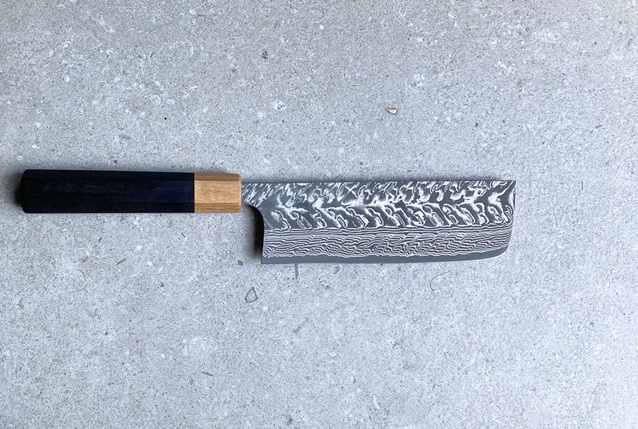The Importance of Nakiri Knives and How to Use Them
A good kitchen knife can change the way you cook, making preparation quicker, safer, and more enjoyable. There are many knives on the market, but few of them are as simple as the Nakiri knife. It originated in Japan and has a rectangular-shaped blade. It’s made for clean and effortless cuts of veggies. Once you understand how to properly use it, you’ll see a big change in your cooking routine.
What Is a Nakiri Knife?

This is a traditional Japanese vegetable knife. It’s known for its flat, rectangular blade and double-edged design. Compared to Western knives that have a curved blade that allows rocking motions, this one has a straight edge. This allows very precise, clean cuts by moving it straight down through the food.
The professional Japanese nakiri knife has a design that’s perfect for chopping, dicing, and slicing veggies and not crushing them in the process. The blade is thin and lightweight and gives you more control over the cuts while working with delicate produce like leafy greens and herbs.
Using it doesn’t require awkward wrist movements because the knife has a squared-off tip, which makes it easy to guide along the chopping board. This is a knife that’s valued not just in Japanese households but all over the world because of its ability to create uniform slices.
Why are These Knives Important in the Kitchen
A kitchen equipped with the right knives is set to be a successful kitchen. A vegetable knife like this only adds to the experience because of its many advantages. Its straight blade ensures vegetables are cut cleanly from top to bottom while still keeping the edges smooth and neat. This type of precision is important when you need consistent slices. This is the case when prepping and cooking stir-fries and roasted vegetables.
Their efficiency is also an important factor. The blade is thin, sharp, moves easily through different types of produce and doesn’t stick. The recognisable rectangular shape means you can cut more with every motion. This saves you time and effort during meal prep.
This is a great knife for people who love working with fresh ingredients. It encourages cleaner technique and gives better control. Beginner chefs love it because of the lightweight blade and balanced handle because these factors make it more comfortable to hold and work with.
How to Use it Properly
Once you learn proper technique, using this veggie knife is very easy. The most important thing is to focus on a straight up-and-down cutting motion instead of rocking the blade. Remember, hold the handle firmly but not too tightly while keeping your wrist relaxed. Guide the ingredients with the other hand and curl the fingers slightly inward for protection.
Keep the blade in contact with the cutting board through each movement because the blade is flat. Just lift it slightly between cuts and bring it down again. This cutting style gives you even slices. Having a good chopping surface is also important. Wooden or soft plastic chopping boards are best because they won’t dull the nakiri. Don’t use glass or stone boards. They can cause chips and reduce the knife’s sharpness.
This knife works so well with so many different ingredients. It cuts cleanly through tomatoes, cucumbers, onions, carrots, and cabbage. It also does a great job with softer produce like zucchini and mushrooms and with herbs. If you’re working with something harder like sweet potatoes or pumpkins, go slowly and let the blade do the work. There’s no need to apply a lot of pressure.
Care and Maintenance
Taking care of your nakiri knife will extend its lifespan and keep it sharp and safe. Clean it as soon as you finish using it. Use mild soap and warm water and dry it off completely with a soft cloth. Don’t leave it soaking in water because the blade and handle can get damaged.
Never place the knife in a dishwasher. The high heat and harsh detergents can weaken the steel and cause the edge to dull quickly. Don’t use a pull-through sharpener to sharpen the Nakiri knife. Use a whetstone instead. A few light passes every month will keep it sharp and ready to use.
Storing the knife properly is another part of its maintenance routine. The right way to store it is to keep it in a knife block, a protective sheath or a magnetic strip. This way it doesn’t come in contact with other utensils. With regular cleaning and care, your veggie knife will stay in great condition for many, many years to come.
Choosing the Right Nakiri Knife
Choosing the right knife depends on several factors. The first one is blade material. The three main choices are carbon steel, stainless steel and Damascus. Carbon steel is very sharp and holds the edge well. Stainless steel is stain-resistant and doesn’t require a lot of maintenance. And Damascus is beautiful, strong and looks extremely elegant.
The handle is also important. The handle also matters. Traditional Japanese knives often have wooden handles, which give a natural feel and a good grip. Modern options often use composite or resin materials because of durability and moisture resistance. No matter which one you choose, it should feel comfortable and balanced in your hand.
Weight and size also matter. A lighter knife is easier to control and allows quicker movements. A heavier one will give you more stability when dealing with tougher vegetables. Price is also a factor because it reflects the craftsmanship and materials used in making the knife. However, there are well-made mid-range knives that will serve you equally as well as more expensive ones.
In Summary
The Nakiri knife has earned its place as a favourite among cooks who value precision and efficiency. Its simple design makes it easy to use, and the sharp edge makes perfect cuts every time. Learning how to handle and care for it can improve both your confidence and results in the kitchen.



